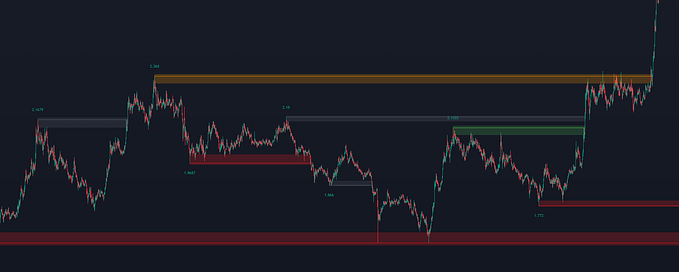Introduction to futures contracts and basis trading

In this opening expo into the derivatives markets and trading, we will dive into the futures market as it is largely the engine behind keeping equilibrium in the Soteria ecosystem.
19th century futures trading
Futures trading on a formal futures exchange in the U.S. originated with the formation of the Chicago Board of Trade (CBOT) in the middle of the 19th Century. Grain dealers in Illinois were having trouble with keeping their credit risk to grain counterparties low. The risk of grain prices falling after harvest made lenders reluctant to extend grain dealers credit to purchase grain for subsequent sale in Chicago, the idea being that some farmers may have been bankrupted by extreme price fluctuation. To reduce their risk exposure, grain dealers began selling “To Arrive” contracts, which specified the future date (usually the month) a specified quantity of grain would be delivered to a particular location at a price identified in the contract. This allowed the farmers to be “hedged”. Their net directional exposure, or delta (yes the same delta you see on Deribit) was minimized and they could sleep well at night knowing they have “locked in” their prices. Fixing the price in advance of delivery allowed the farmers’ counterparties to know that they would be monetarily sound if the price of grain tanked, and they would be able to meet financial and contractual obligations in the future. The “To Arrive” contracts were the precursor to the modern futures market today. The modern futures exchanges were formed from these forwards markets to be more liquid, but the concept is the same.
The first U.S. futures exchange was the Chicago Board of Trade (CBOT), formed in 1848. Other U.S. exchanges also began in the last half of the 1800s. The Chicago Mercantile Exchange (CME) was formed in 1874 when the Chicago Product Exchange was organized to trade butter. In each case the exchanges were formed because commercial dealers in corn, wheat and butter needed a way to reduce some of their delta exposure. After all, these people were farmers, not hedge funds. They wanted their day to day activities to be focused on churning out products, not worrying about the aberrations and price swings in the market. However, this worked both ways. While sellers, primarily farmers, wanted to lock in an inventory price, buyers wanted to lock in a purchase price. This can be related to an airline purchasing oil to hedge out increasing costs (albeit basis risk to a listed contract-something we will cover later).
So what exactly is a futures contract?
A futures contract is a binding agreement between a seller and a buyer to make (seller) and to take (buyer) delivery of the underlying commodity (or financial instrument) at a specified future date with agreed upon payment terms. Most futures contracts don’t actually result in delivery of the underlying commodity. Instead, most traders net out their position before expiry. The trader then trades in the cash/spot market if they want to transact in the security still. When this doesn’t occur however, one may take physical delivery of the product. If you think back to the negative oil crisis in 2020, this is exactly what happened, except there was no local empty storage in Cushing, the site of delivery. This resulted in the price plummeting as all longs were forced to sell before expiry, but very few buyers could buy and accept delivery on account of the storage deficit.
Now that we have this intro, in the future we will hope to cover the technicalities of the contracts such as basis, term structure, and rolldown.
Futures in crypto
There are two main types of futures on FTX, the venue of which Soteria will extract yield until a decentralized venue that can handle liquidity with minimal price impact. The first of which is a perpetual future. The second is a dated future. We will explore both here.
As of this writing, FTX has the dated futures listed for upcoming quarters, meaning June, September, and December. These expire on the last Friday of every quarter to a 1 hour TWAP of the underlying index from 2am UTC to 3am UTC. Shortly after expiration, each futures position will be marked to the expiration price of the contract. All realized and unrealized PnL on quarterly futures will turn into collateral and the process is over.
Example: You deposit $10,000 of collateral and used it to buy 10 BTC quarterly futures. Prior to expiration your account had 10 BTC quarterly futures with a realized PnL of $1,000, an unrealized PnL of $100, and a mark price of $5,000 for the BTC index. If the average price of the BTC index over the expiration period (2am to 3am UTC) was $5,010, then after expiration ended your account would have:
USD collateral: $10,000 (old collateral) + $1,000 (realized PnL) + $100 (unrealized PnL) + 10 (number of BTC futures) * ($5,010 — $5,000) (difference between expiration and previous mark price) = $11,200
These are in contrast to perpetual futures. Perpetual futures don’t expire to a listed date as a quarterly would. Instead, every hour, each perpetual contract has a funding payment where longs pay shorts equal to the 1 hour TWAP/24. This incentivizes the market/arbitragers to keep this future in line with what the spot price is trading at.
In times of extreme demand or after a large downward move after many traders have been liquidated and are forced to dump perpetuals, you will often find this funding rate to be extreme. This can create an interesting opportunity to provide liquidity in these perpetuals. For example, in a large crypto drawdown, perpetual funding may go negative, meaning shorts pay longs, effectively making this perpetual cheaper than spot. One would be able to buy spot and sell this perpetual to collect a funding payment until this dislocation converges, and then close out of the position by buying back to perpetual and selling spot. You remain delta neutral in this trade and are agnostic to price direction.
This similar logic can be applied to the quarterly futures as well. Futures typically exhibit a contango on the forward curve, meaning the June futures are trading higher than spot, September higher than June and etc. The slope is upward sloping. If the opposite were true and the front months were higher than the later months, this would be called backwardation. There is already some opportunity set in any contango market, as similar to the perpetuals, one could buy the lower one and sell the higher one. The two must converge wither via the path of prices discretely or at expiration. For example, if spot bitcoin is trading at $50,000 and the December future is trading at $55,000, one could sell the future and buy spot for a 10% profit by December. If the curve shifts in between the current date and December, the trader may find it prudent to just close out of the position there and then instead of waiting to expiry. This sounds great! However, it sometimes gets better. In bull markets when there is demand for upside, the forward curve can become very steep, and instead of 10%, you may be able to find a 40% difference in spot and the December future. This trade doesn’t come without risks though, the primary one being liquidation on your perpetual. This is a very path dependent trade. Even though by the December expiry, you should expect to make that 10% surplus, the months in between can be very volatile and maybe the trader in this position gets liquidated before then. Perhaps Elon Musk announces he will start a new colony on Mars and will institute bitcoin as the main currency, and this causes a bullish frenzy. Being short the perpetual in times of extreme bullishness could mean liquidation as the forward curve upward slope will steepen and you are short a rising perpetual. If the proper margin isn’t being accompanied with the trade, you will just be left with the spot long.
Basis Trading
This forward curve contango is the basis(no pun intended) for which Soteria will use to generate yield on the stable coin. We will dive into each of these previously mentioned topics more in depth in later articles now that you are familiar with the basics, as well as how these trades are used in traditional markets.
Although it is possible for the futures price to trade below the spot price (also known as backwardation), it is far more common for the futures to be trading at a price higher than the spot price (also known as contango).
In a cash and carry trade seeking to take advantage of contango, the trader will purchase the underlying asset (e.g. bitcoin) in a spot market. They will then short the same asset using a dated futures contract that is currently trading at a premium. This corresponding short position means there is no exposure to price movements in the underlying asset (delta neutral).
The big advantage the trader has when executing a cash and carry trade is the knowledge that the futures contract has a fixed expiry date, at which time the futures contract will be settled using the spot price. This is known as convergence and is what makes this trade so attractive. By the expiry date, the two prices must be the same.
No trader can know for sure exactly what the price of an asset will be on any given date in the future, but they do know that the difference between the spot price and the futures price will tend towards zero as the time to expiry approaches zero. The two can even converge to the same price before the expiry date, given earlier potential profits.
Consider if bitcoin is currently trading at $35,000, while the December future trades at $50,000.
This results in a $15,000 premium or roughly 42.8% of the spot investment.
To carry out this cash and carry trade we will need to do two things
1) Purchase the underlying asset.
2) Short a futures contract for the same asset.
Here the trader purchases 1 bitcoin for $35,000 on the spot exchange. They then short the December futures contract on a derivatives exchange with a position size of 1 bitcoin, which on the June futures contract is $50,000.
All that remains is to wait for the difference between these two prices to decrease, then the trade can be closed for a profit. It doesn’t matter whether the underlying price goes up or down overall, just that the difference between the future price and spot price decreases.
Let’s assume the trader has waited a few weeks since opening the position, and the premium has now reduced to zero i.e. the December future price equals the spot price. One can now buy back the future and sell spot to close out the position.
While we focused this on monthly/quarterly expirations, this can also be done with perpetual futures. Instead of convergence however on a particular date, you would receive funding payments instead via the timing of the derivatives exchange you are using, usually every few hours.
Word of caution: If you are trading the basis, do not size too largely. This is a highly path dependent trade. Although you can expect convergence by expiry, the basis can move greatly against you in the interim. This can potentially liquidate your short futures leg, leaving you in the red for the trade and owning unwanted deltas.








